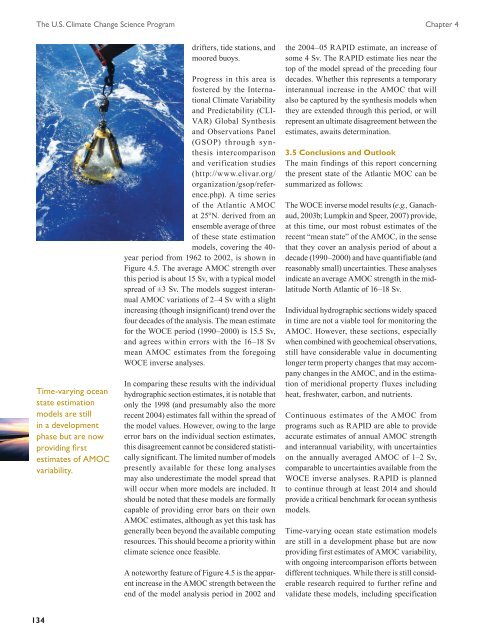Book 2.indb - US Climate Change Science Program
Book 2.indb - US Climate Change Science Program
Book 2.indb - US Climate Change Science Program
- No tags were found...
You also want an ePaper? Increase the reach of your titles
YUMPU automatically turns print PDFs into web optimized ePapers that Google loves.
The U.S. <strong>Climate</strong> <strong>Change</strong> <strong>Science</strong> <strong>Program</strong> Chapter 4Time-varying oceanstate estimationmodels are stillin a developmentphase but are nowproviding firstestimates of AMOCvariability.drifters, tide stations, andmoored buoys.Progress in this area isfostered by the International<strong>Climate</strong> Variabilityand Predictability (CLI-VAR) Global Synthesisand Observations Panel(GSOP) through synthesisintercomparisonand verification studies(http://www.clivar.org/organization/gsop/reference.php).A time seriesof the Atlantic AMOCat 25°N. derived from anensemble average of threeof these state estimationmodels, covering the 40-year period from 1962 to 2002, is shown inFigure 4.5. The average AMOC strength overthis period is about 15 Sv, with a typical modelspread of ±3 Sv. The models suggest interannualAMOC variations of 2–4 Sv with a slightincreasing (though insignificant) trend over thefour decades of the analysis. The mean estimatefor the WOCE period (1990–2000) is 15.5 Sv,and agrees within errors with the 16–18 Svmean AMOC estimates from the foregoingWOCE inverse analyses.In comparing these results with the individualhydrographic section estimates, it is notable thatonly the 1998 (and presumably also the morerecent 2004) estimates fall within the spread ofthe model values. However, owing to the largeerror bars on the individual section estimates,this disagreement cannot be considered statisticallysignificant. The limited number of modelspresently available for these long analysesmay also underestimate the model spread thatwill occur when more models are included. Itshould be noted that these models are formallycapable of providing error bars on their ownAMOC estimates, although as yet this task hasgenerally been beyond the available computingresources. This should become a priority withinclimate science once feasible.A noteworthy feature of Figure 4.5 is the apparentincrease in the AMOC strength between theend of the model analysis period in 2002 andthe 2004–05 RAPID estimate, an increase ofsome 4 Sv. The RAPID estimate lies near thetop of the model spread of the preceding fourdecades. Whether this represents a temporaryinterannual increase in the AMOC that willalso be captured by the synthesis models whenthey are extended through this period, or willrepresent an ultimate disagreement between theestimates, awaits determination.3.5 Conclusions and OutlookThe main findings of this report concerningthe present state of the Atlantic MOC can besummarized as follows:The WOCE inverse model results (e.g., Ganachaud,2003b; Lumpkin and Speer, 2007) provide,at this time, our most robust estimates of therecent “mean state” of the AMOC, in the sensethat they cover an analysis period of about adecade (1990–2000) and have quantifiable (andreasonably small) uncertainties. These analysesindicate an average AMOC strength in the midlatitudeNorth Atlantic of 16–18 Sv.Individual hydrographic sections widely spacedin time are not a viable tool for monitoring theAMOC. However, these sections, especiallywhen combined with geochemical observations,still have considerable value in documentinglonger term property changes that may accompanychanges in the AMOC, and in the estimationof meridional property fluxes includingheat, freshwater, carbon, and nutrients.Continuous estimates of the AMOC fromprograms such as RAPID are able to provideaccurate estimates of annual AMOC strengthand interannual variability, with uncertaintieson the annually averaged AMOC of 1–2 Sv,comparable to uncertainties available from theWOCE inverse analyses. RAPID is plannedto continue through at least 2014 and shouldprovide a critical benchmark for ocean synthesismodels.Time-varying ocean state estimation modelsare still in a development phase but are nowproviding first estimates of AMOC variability,with ongoing intercomparison efforts betweendifferent techniques. While there is still considerableresearch required to further refine andvalidate these models, including specification134






